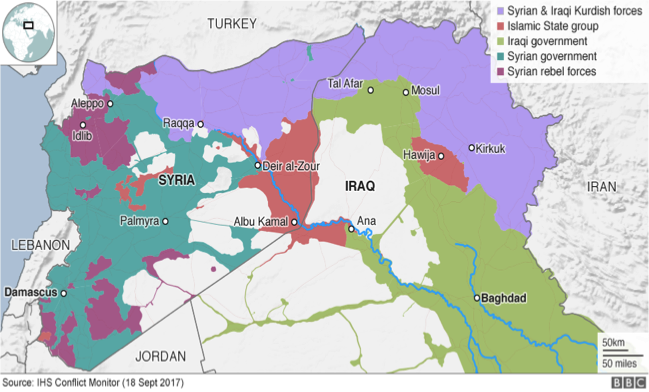Iran Set to Entrench Control, Profit as Syria Looks to Rebuild
On September 26, Iran’s Research Institute of Petroleum, a governmental research institute affiliated with the National Iranian Oil Company (NIOC), announced that Iran is planning to build an oil refinery in Syria’s western city of Homs once the civil war has ended as part of a consortium involving Iranian, Syrian, and Venezuelan companies. The consortium has already began pursuing international investments for the project, which will take an estimated $1 billion to construct and will have a projected refining capacity of 140,000 barrels per day.
The Homs oil refinery is the latest in a series of business deals Iran has announced this year that indicate that the Islamic Republic is poised to take a leading role in the rebuilding of Syria, after playing a pivotal role in the nation’s destruction. Earlier in September, Iran signed a series of lucrative agreements to restore Syria’s power grid and in January, the Iranian government and Islamic Revolutionary Guard Corps (IRGC)-affiliated entities inked major mining and telecommunications agreements with Damascus.
The Syrian Civil War has severely degraded the Syrian Army’s fighting abilities and weakened President Bashar al-Assad’s political authority, leaving the Assad regime beholden to Iran for its continued survival. Iran is effectively in charge of planning and leading the conduct of the conflict and has provided the Assad regime with a nearly $6 billion line of credit. Iran ordered Hezbollah into the conflict and recruited thousands of Shi’a mercenary fighters from the Middle East, Afghanistan and Pakistan to fight in Syria who now form the core of pro-Assad forces in the country.
Iran’s Syrian intervention has paid off, as Assad’s survival seems assured while his weakened position both domestically and within the international community all but guarantees he will remain a subservient Iranian client. For its efforts to shore up Assad, Iran and the IRGC – which has a hand in virtually every sector of the Iranian economy – are positioned to further carve out a long-term role for themselves in Syria, utilizing the cover of military and economic projects to export the Islamic Revolution by creating Shi’a militias and quasi-state institutions loyal to Iran and its Supreme Leader within Syria. Iran and the IRGC are also set to profit massively from the rebuilding process. Iranian officials have gone so far as to refer to Syria as Iran’s 35th province, and accordingly, Iran seems contented to exploit Syria’s natural resources and help itself to the spoils of war.
 Iran’s objective in Syria has evolved from creating a “Useful Syria” from the regime’s major cities and economic centers into a more ambitious campaign to retake the entire country in order to create a land-bridge that would link its own territory to Hezbollah’s Beqaa valley stronghold via Iraq and Syria. The U.S. must articulate a coherent and comprehensive strategy to contain Iranian expansion within Syria. Such a strategy must be backed by credible deterrence to ensure that hard-won gains of former ISIS territory not fall into the hands of the Assad-Russia-Iran-Hezbollah axis. It should also seek to bolster the capacity of the Arab and Kurdish Syrian Democratic Forces to hold territory.
Iran’s objective in Syria has evolved from creating a “Useful Syria” from the regime’s major cities and economic centers into a more ambitious campaign to retake the entire country in order to create a land-bridge that would link its own territory to Hezbollah’s Beqaa valley stronghold via Iraq and Syria. The U.S. must articulate a coherent and comprehensive strategy to contain Iranian expansion within Syria. Such a strategy must be backed by credible deterrence to ensure that hard-won gains of former ISIS territory not fall into the hands of the Assad-Russia-Iran-Hezbollah axis. It should also seek to bolster the capacity of the Arab and Kurdish Syrian Democratic Forces to hold territory.
Finally, the U.S. should consider designating the entirety of the IRGC as a foreign terrorist organization, and in particular should target IRGC entities engaged in war profiteering in Syria as a means of staunching the IRGC’s attempted takeover of Syria. Entities meriting scrutiny include the MAPNA group, an Iranian power plant management corporation with suspected IRGC links tasked with constructing five gas-powered power plants in Aleppo, and Mobile Telecommunication Company of Iran (MCI), an entity linked to the IRGC and the supreme leader, which was granted a license to operate a mobile network in Syria.
Jordan Steckler is a research analyst at United Against Nuclear Iran (UANI).
Receive Iran News in Your Inbox.
Eye on Iran is a news summary from United Against Nuclear Iran (UANI), a section 501(c)(3) organization. Eye on Iran is available to subscribers on a daily basis or weekly basis.